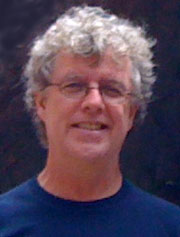Bruce Demple
 2009 - present, Professor of Pharmacological Sciences, Stony Brook University Medical
School
2009 - present, Professor of Pharmacological Sciences, Stony Brook University Medical
School
1984 - 2009, Assistant to Full Professor, Harvard University
1981, Ph.D., Biochemistry, University of California, Berkeley 1984, Postdoctoral, Imperial Cancer Research Fund, London, UK
1976-1981, B.A., Biology, Wesleyan University
Bruce Demple's research has engaged a range of topics at the intersection of biomedicine and the environment. This interest has been driven by trying to understand how cells defend against damaging molecules that are endogenous to cells but also produced by environmental agents. One strong theme has been defining the biochemical and biological functions of repair pathways for oxidative DNA damage. Another major theme of his work has been discovering and defining genetic regulatory systems that govern cellular responses to oxidative stress and nitric oxide. These two areas synergize in various ways: for example, the oxidative stress caused by arsenite exposure activates the APE1 gene, which encodes a central component of DNA repair and is vital to cell survival. Recent studies expanded his analysis to mitochondria, the cellular energy organelles that maintain their own DNA genome. DNA repair in mitochondria was considered very limited, but these studies have demonstrated new proteins and pathways that were previously thought lacking. Investigations continue on Ape1 protein functions in the cell beyond DNA repair, and on understanding the mechanisms that partition oxidative DNA lesions among competing repair and mutational pathways.
Some recent publications
Auerbach, P.A. and B. Demple, Roles of Rev1, Pol zeta, Pol32 and Pol eta in the bypass of chromosomal abasic sites in Saccharomyces cerevisiae. Mutagenesis, 2010. 25(1): p. 63-9.
Son, M.Y., Jun, H. I., Lee, K. G., Demple, B. and J.S. Sung, Biochemical evaluation of genotoxic biomarkers for 2-deoxyribonolactone-mediated cross-link formation with histones. J Toxicol Environ Health A, 2009. 72(21-22): p. 1311-7.
Liu, P., Qian, L., Sung, J. S., de Souza-Pinto, N. C., Zheng, L., Bogenhagen, D. F., Bohr, V. A., Wilson, D. M., 3rd, Shen, B. and B. Demple,Removal of oxidative DNA damage via FEN1-dependent long-patch base excision repair in human cell mitochondria. Mol Cell Biol, 2008. 28(16): p. 4975-87.
Fung, H., P. Liu, and B. Demple, ATF4-dependent oxidative induction of the DNA repair enzyme Ape1 counteracts arsenite cytotoxicity and suppresses arsenite-mediated mutagenesis. Mol Cell Biol, 2007. 27(24): p. 8834-47.
Sung, J.S., M.S. DeMott, and B. Demple, Long-patch base excision DNA repair of 2-deoxyribonolactone prevents the formation of DNA-protein cross-links with DNA polymerase beta. J Biol Chem, 2005. 280(47): p. 39095-103.
Fung, H. and B. Demple, A vital role for Ape1/Ref1 protein in repairing spontaneous DNA damage in human cells. Mol Cell, 2005. 17(3): p. 463-70.
Lee, P.E., B. Demple, and J.K. Barton, DNA-mediated redox signaling for transcriptional activation of SoxR. Proc Natl Acad Sci U S A, 2009. 106(32): p. 13164-8.
Kuwano, Y., Rabinovic, A., Srikantan, S., Gorospe, M. and B. Demple, Analysis of nitric oxide-stabilized mRNAs in human fibroblasts reveals HuR-dependent heme oxygenase 1 upregulation. Mol Cell Biol, 2009. 29(10): p. 2622-35.
